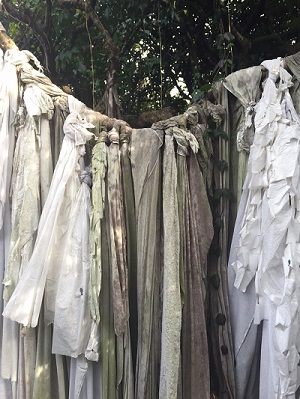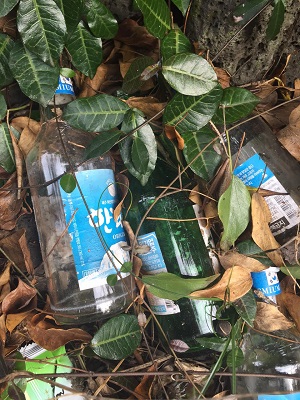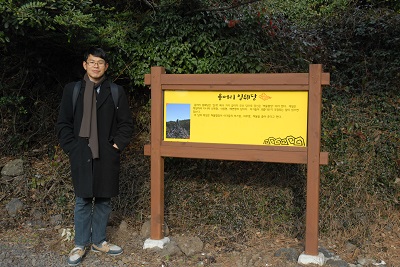| |
 |
|
| ▲ Sacred cloth at a village shrine. Photo by The Jeju Weekly |
The birth of Onpyeong-ri is the birth of Tamna, or so locals emphasize.
According to the founding myth of Tamna (?-1105), Jeju Island’s indigenous civilization, the three demigods Go, Yang, and Bu encountered three princesses from a mysterious foreign kingdom and consummated their union at Honinji cave in present-day Onpyeong, southeast Jeju.
In Onpyeong’s main shamanic shrine myth, the third princess took her place at Onpyeong some 1,500 years ago and became known as “Mengho Buin,” while her two elder sisters presided over Jocheon and Gimnyeong in Jeju’s northeast.
For locals, the village’s semi-divine origins and close connection with the Tamna legend is both a serious matter and a source of pride.
The myth affirms Onpyeong’s importance to Jeju’s distant past as the place where two peoples – native and foreign – came together to become the forebears of today’s Jeju Islanders.
Taking into consideration its pride as the place where two peoples united for a common goal in Jeju mythology, the present situation is a bitter irony to many in this part of the island.
| |
 |
|
| ▲ Soju bottles at a village shrine. Photo by The Jeju Weekly |
The region comprising Onpyeong-ri and the surrounding villages recently took center stage in the debate on the future and consequences of Jeju’s tourism development.
In November 2015, the National Land, Infrastructure, and Transportation Ministry suddenly declared that this would be the primary location for Jeju’s second airport project.
But while the village is embroiled in a heated debate, the people of Onpyeong would rather welcome visitors with the warmth of their hospitality and their fireside stories of yesteryear.
Indeed, the most conspicuous aspect of Onpyeong-ri’s residents is their tendency to have a striking mix of an upfront feistiness combined with a rural hometown hospitality.
If there is any truth to the local version of the Tamna founding myth that foreign princesses arrived at the shores of Onpyeong, the residents here would easily have been agreeable hosts.
The name “Onpyeong,” which means “warm peace,” actually is a product of Japanese colonial rule (1910-1945).
According to maps and records in the Joseon Dynasty (1392-1910), Onpyeong was known as “Yeoruni,” a Jeju pronunciation of a Chinese character compound “Yeonhonri” that refers to the Honinji legend.
| |
 |
|
| ▲ The author Tommy Tran. Photo by The Jeju Weekly |
What would become the current village of Onpyeong was settled some 750-800 years ago by the Mun and Ham families and the local place name of “Mugeun Yeoruni,” slightly further inland, is recognized today as the original site.
Much of Onpyeong’s (or Yeoruni’s) history is shrouded in myth and legend, but ancient sites and remnants scattered around the village’s environs are physical testaments to its long history.
Including the bonhyangdang (village main shrine), Onpyeong has six documented shamanic shrines, all of which are located in or near natural formations of astounding beauty.
Devotion to the island’s indigenous gods remains strong to this day. Aside from the annual Maeulje, a Confucian-shamanic village-wide ritual, and Yeongdeung-gut wind goddess rituals, Onpyeong villagers visit the Ilrwe-dang (Seventh Day Shrine) at least once a month to pray for healing and the wellbeing of family members.
A former woman diver, recounting the story of when a fellow diver was lost at sea some years ago, noted that the sudden bout of bad weather on that fateful day was due to the tutelary goddess refusing permission to return to shore.
Onpyeong’s coast must have had many other tragic tales as evidenced in the remains of a Joseon Dynasty naval post and the Goryeo Dynasty (918-1392) Hwanhaejangseong seaside fortress walls still visible along the coastal road.
Many tourists and Olle trail walkers pass through the village of Onpyeong, but few are aware of its remarkable history and rich culture.
As Jeju’s landscapes are increasingly threatened due to apathy or overzealous development, the question of its cultural identity and the value of its traditions, have never been more pertinent.
In guarding the traditions and wisdom of their forebears, many stalwart villagers of Onpyeong hope that their descendants, as well as curious visitors, will honor the legacy of their ancestors just as the three foreign princesses did some eons ago. |






















